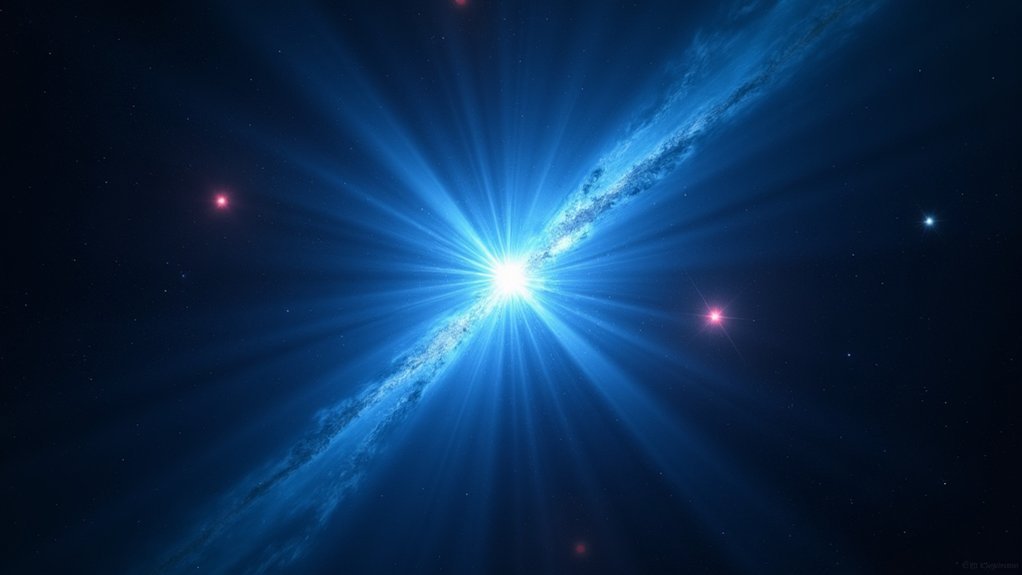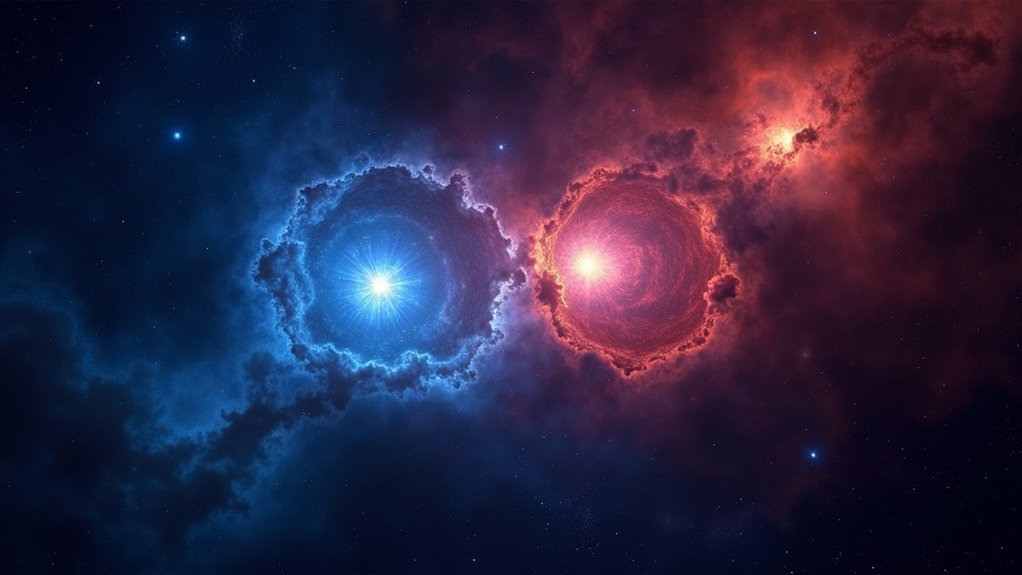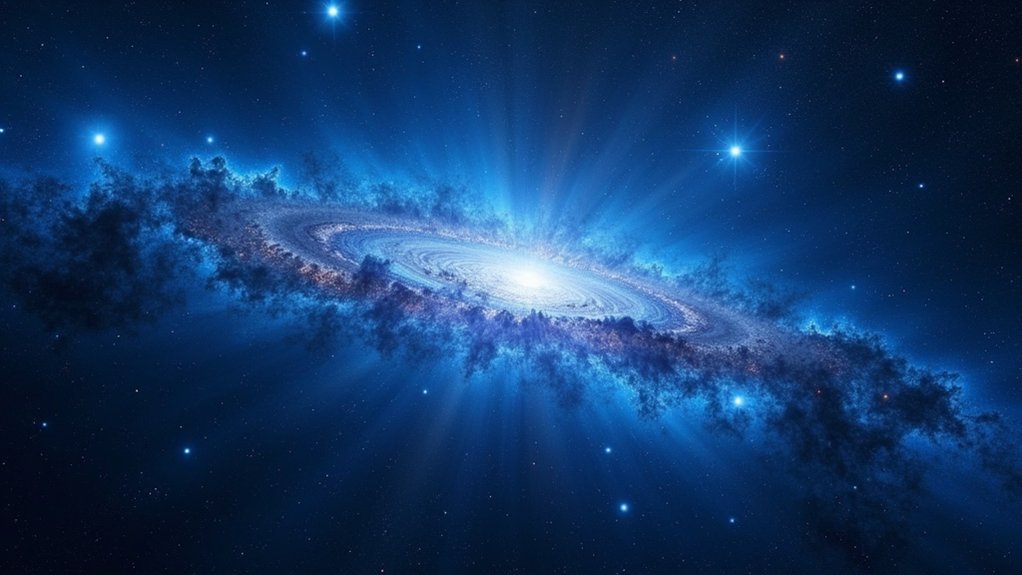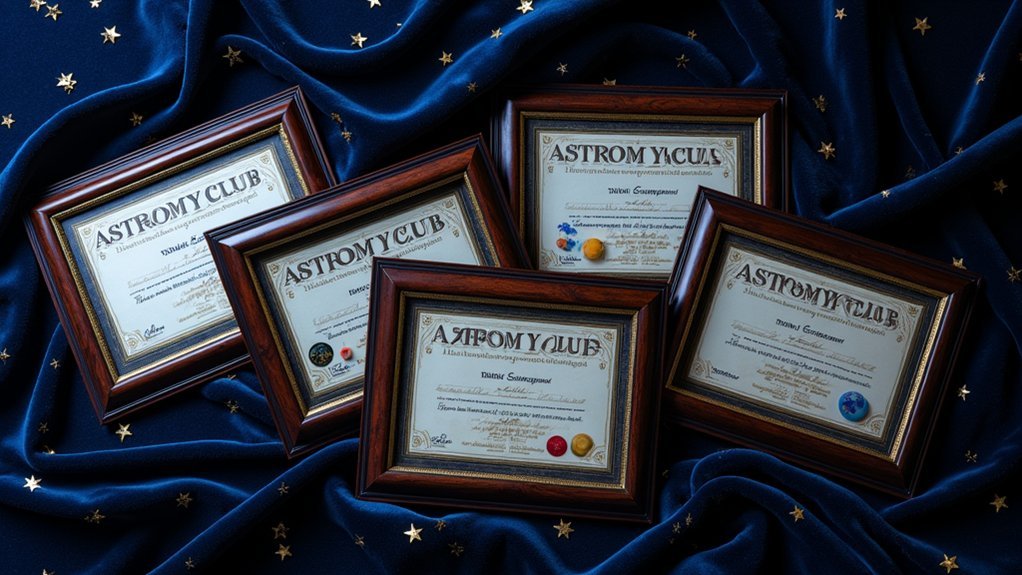Blue stars are hotter than red stars because of Wien’s law, which states that hotter objects emit light at shorter wavelengths. Stars with surface temperatures above 10,000K appear blue, while cooler stars (2,000-4,000K) look red. A star’s mass primarily determines its temperature—more massive stars create higher gravitational pressure, leading to hotter cores and more intense nuclear fusion. The relationship between color and temperature reveals fundamental properties about a star’s life cycle and energy output.
The Physics of Stellar Temperature

While you might think a star’s color is merely aesthetic, it actually reveals fundamental physical properties about the celestial body. What you’re seeing is a direct manifestation of the star’s surface temperature, governed by Wien’s law. This principle dictates that hotter objects emit light at shorter wavelengths—blue stars shine at the shorter, bluer end of the spectrum because they’re scorching hot.
Blue stars maintain surface temperatures exceeding 10,000 K, dramatically hotter than their red counterparts, which operate at a relatively cool 2,000-4,000 K. This temperature difference isn’t just academic—it translates to vastly different energy outputs.
Following the Stefan-Boltzmann law, a star’s energy emission increases with the fourth power of its temperature, making blue stars extraordinarily more energetic and powerful than red ones.
Understanding Wien’s Law and Blackbody Radiation
When you look at different colored stars in the night sky, you’re witnessing Wien’s Law in action—hotter stars emit radiation that peaks at shorter, bluer wavelengths while cooler stars peak in the red.
These shifting radiation peaks create distinctive blackbody curves, with every star emitting a spectrum of light determined by its surface temperature.
The intensity of this radiation increases dramatically at higher temperatures, which explains why blue stars (around 10,000 K) outshine red stars (around 3,000 K) of similar size, despite emitting light across all wavelengths.
Wien’s Law Simplified
The relationship between a star’s temperature and its color boils down to a fundamental principle in physics called Wien’s Law. This law tells you that the peak wavelength of light emitted by a star is inversely proportional to its temperature – simply put, hotter stars emit shorter wavelengths.
When you look at the night sky, you’re witnessing Wien’s Law in action:
- Blue stars shine at temperatures between 10,000-40,000K, emitting primarily short-wavelength blue and ultraviolet light.
- Yellow stars like our Sun operate at moderate temperatures around 5,500K.
- Red stars glow at cooler temperatures of 2,000-3,200K, releasing longer wavelength infrared and red light.
This powerful relationship lets astronomers determine a star’s temperature just by analyzing its color spectrum.
Radiation Peaks Shift
Stars across the universe reveal their temperatures through a predictable shift in their radiation peaks, a phenomenon perfectly explained by blackbody radiation principles. When you observe stars of different colors, you’re witnessing Wien’s Law in action – hotter objects emit at shorter wavelengths.
| Star Temperature | Peak Wavelength | Visible Color |
|---|---|---|
| 3,000 K | Infrared/Red | Red |
| 5,800 K | Yellow-green | Yellow |
| 8,000 K | Blue-violet | White-blue |
| 10,000+ K | Ultraviolet | Bright blue |
As a star’s temperature increases, its radiation peak shifts toward the blue end of the spectrum. This shift isn’t just a visual curiosity – it represents considerably higher energy output. Blue stars emit more high-energy photons, making them both hotter and more luminous than their red counterparts.
Blackbody Curve Explained
Understanding the blackbody curve reveals why stars shine in their characteristic colors across the night sky. This fundamental concept demonstrates how objects emit radiation across wavelengths based on their temperature. When you observe stars of different colors, you’re witnessing Wien’s Law in action.
The blackbody curve explains stellar colors through:
- Temperature correlation – Hotter stars (10,000+ K) emit peak radiation at shorter wavelengths, appearing blue, while cooler stars (around 3,000 K) emit at longer wavelengths, appearing red.
- Energy distribution – As temperature increases, the blackbody curve’s peak shifts toward ultraviolet wavelengths, causing blue stars to emit more energy in the visible blue spectrum.
- Intensity differences – Following Stefan-Boltzmann law, a star’s energy output increases with the fourth power of its temperature, making hot blue stars dramatically brighter per unit area.
How Mass Influences Star Temperature
When examining stellar characteristics, mass emerges as the primary factor determining a star’s temperature. A star’s mass directly controls its gravitational pressure, which in turn affects core temperatures where nuclear fusion occurs.
You’ll find this connection best expressed in the mass-luminosity relationship, where more massive stars generate substantially higher luminosity and temperature. Blue stars, with masses often exceeding several times that of our sun, create intense gravitational pressure that drives core temperatures high enough to rapidly fuse hydrogen.
In contrast, red stars have lower masses, resulting in reduced gravitational compression and cooler temperatures between 3,000-4,000 K. This fundamental difference explains why massive blue stars burn through their nuclear fuel at an accelerated pace, while their smaller red counterparts maintain steady fusion reactions over much longer lifespans.
Nuclear Fusion Rates in Different Star Types

The nuclear fusion processes that power stars vary dramatically based on their mass classification. You’ll find that blue stars, with their massive gravitational pressure and core temperatures exceeding 10,000 K, sustain considerably higher nuclear fusion rates than their red counterparts. This difference shapes their entire stellar lifecycle.
Here’s how fusion rates impact different star types:
- Energy production – Blue stars convert hydrogen into helium much more rapidly, generating the intense luminosity that makes them shine so brightly.
- Lifespan duration – Red stars burn fuel slowly at 3,000-5,000 K, extending their lives to billions of years versus mere millions for blue stars.
- Evolutionary destiny – Higher fusion rates in blue stars lead to supernovae endings, while red stars typically become white dwarfs.
The Color-Temperature Connection in Astronomy
Stars reveal their temperatures through the striking colors we observe in the night sky, creating a reliable astronomical thermometer visible across vast distances. When you look at stars, you’re witnessing Wien’s law in action: hotter stars emit shorter, bluer wavelengths, while cooler stars radiate longer, redder wavelengths.
The night sky reveals stellar temperatures through color—nature’s distant thermometer showing us Wien’s law with every twinkling point of light.
Astronomers quantify this relationship using the B-V color index, where blue stars register negative values and red stars show positive readings. The hottest blue stars, with surface temperatures exceeding 10,000 K, mainly emit ultraviolet radiation with visible blue light.
In contrast, cooler red stars (around 3,000 K) primarily emit infrared and red wavelengths.
This color-temperature connection isn’t affected by distance—a blue star’s appearance comes directly from its black body radiation, offering consistent temperature clues regardless of location.
Spectral Classification and Star Colors

The colors of stars directly relate to their temperatures through Wien’s Law, which shows that hotter objects emit light at shorter wavelengths, making blue stars appear blue and red stars appear red.
You’ll notice this connection when comparing the energies at stellar surfaces, where blue O and B stars radiate at over 10,000 K while red M and K stars operate below 4,000 K.
This temperature difference creates distinct spectral signatures that astronomers use to classify stars, with negative B-V color indices for blue stars indicating their greater emission of blue light compared to the redder wavelengths dominant in cooler stars.
Wien’s Law Explained
Understanding why stars shine with different colors requires a fundamental principle in physics: Wien’s Law. This law states that a star’s peak wavelength emission is inversely proportional to its temperature.
Simply put, hotter stars emit light at shorter wavelengths, which is why blue stars burn much hotter than red ones.
Wien’s Law explains three key aspects of stellar temperatures:
- Blue stars reach scorching temperatures of up to 40,000 K, emitting significant ultraviolet radiation beyond what we can see.
- Red stars operate at relatively cooler temperatures around 2,000-3,000 K, producing their characteristic ruby glow.
- Astronomers quantify these differences using the B-V color index, where blue stars have negative or low values while red stars have higher positive values.
Stellar Surface Energies
Wien’s Law gives us the foundation, but a star’s spectral classification reveals its complete energy profile. When astronomers organize stars by their spectral signatures, they’re fundamentally sorting them by surface temperature.
The hottest O and B-type stars appear blue, with temperatures exceeding 10,000 K and intense energy emission, particularly in the ultraviolet spectrum. At the opposite end, stars are red when they fall into the M-type classification, with cooler surface temperatures between 2,500-3,500 K. These stars radiate primarily in the red and infrared wavelengths.
According to the Stefan-Boltzmann law, the energy emission difference is dramatic—blue stars emit substantially more energy per unit area than their red counterparts. This energy distinction places blue stars in the upper left of the Hertzsprung-Russell diagram, while red stars occupy the lower right.
Life Cycles of Red vs. Blue Stars
When comparing stellar life cycles, blue and red stars follow dramatically different paths determined primarily by their mass.
Blue stars live fast and die young, burning through their nuclear fuel in just a few million years, while red stars conserve their resources, often surviving for billions of years.
This mass difference creates three distinct contrasts:
- Lifespan – Blue stars exist for mere millions of years compared to red stars’ billions of years of steady burning.
- Death sequence – Blue stars often end catastrophically in supernovae, leaving neutron stars or black holes, while red stars typically form planetary nebulae with white dwarf remnants.
- Distribution – You’ll find blue stars clustered in younger stellar populations, whereas red stars populate older star clusters throughout the galaxy.
Observing and Identifying Star Colors in the Night Sky

Have you ever noticed that not all stars shine with the same hue? When you gaze upward, the visible light from stars reveals their temperature. The hottest stars appear blue because they emit more radiation in the ultraviolet and blue wavelengths, while cooler stars appear red because they primarily emit red wavelengths.
You can easily identify this difference in constellations like Orion, where blue Rigel contrasts dramatically with reddish Betelgeuse. Astronomers quantify this using color index of a star, with B-V values around -0.4 indicating hot blue stars.
Earth’s atmosphere affects what we see—our sun would appear different from space. While ground observations are helpful, instruments like the Hubble Space Telescope provide clearer views of star colors without atmospheric interference.
Frequently Asked Questions
Are Blue Stars Hotter Than Red Stars?
Yes, blue stars are hotter than red stars. You’ll find blue stars have temperatures exceeding 10,000 K, while red stars are cooler at 3,000-4,000 K. Wien’s law explains this color-temperature relationship perfectly.
Is Blue Star Higher Temperature Than Red Star?
Yes, blue stars are indeed at higher temperatures than red stars. You’ll notice blue stars reach 10,000-40,000 K, while red stars are much cooler at only 2,000-3,200 K. That’s why they appear different colors.
Why Are Red Stars the Coolest?
Red stars are the coolest because you’ll find they have less mass and lower fusion rates. They’re burning their fuel more slowly, which means they can’t generate as much heat as their hotter counterparts.
Why Would a Blue Star Be Higher in Temperature Than a Red Giant?
Blue stars are hotter than red giants because you’ll find their massive cores undergo faster fusion reactions. They’re converting hydrogen to helium more rapidly, generating extreme heat that shifts their light emission toward blue wavelengths.
In Summary
You’ve now discovered that blue stars are hotter than red stars due to Wien’s law—hotter objects emit shorter wavelength radiation. This fundamental principle of physics explains why massive blue giants burn at scorching temperatures while smaller red stars remain cooler. Next time you gaze at the night sky, you’ll recognize these temperature differences in the colorful stellar tapestry above, each hue revealing a star’s true nature.





Leave a Reply